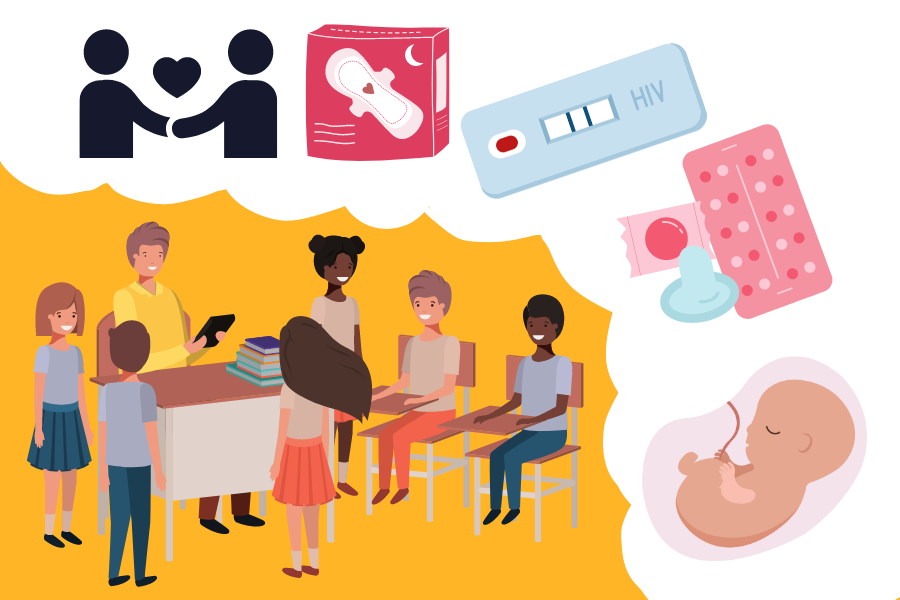Comprehensive sex education needs to be supported and increased in schools.
Data collected in 2010 showed that the U.S. had the highest rate of teen pregnancies out of 21 countries studied. Out of every 1000 teen girls between 15 and 19 years old, about 57 would become pregnant, and 26% of those pregnancies would end in abortions. Not only this, but the U.S. also currently ranks first in the amount of sexually transmitted infections compared to other developed countries.
The number of teen pregnancies in the country is still dangerously high. The U.S. has attempted to lower this by increasing abstinence-only sex education in public schools. Part of the Wellness Reform Act, launched in 1996, was that $50 million were allocated annually to fund this type of Sex Education.
Abstinence-only education emphasizes sex after marriage and that abstaining from those activities is the only sure way to avoid STIs and pregnancy. Studies have shown that abstinence-only education has harmful impacts on students and is not effective in reducing pregnancy rates in teens.
The Bush Administration heavily funded this way of teaching up until 2009 when the Obama administration shifted to supporting comprehensive sex education that highlighted making smart decisions and how to be safe.
A study on abstinence-only sex education from the National Library of Medicine Education wrote, “Abstinence-only curricula have been found to contain scientifically inaccurate information, distorting data on topics such as condom efficacy, and promote gender stereotypes. In contrast, comprehensive sexuality education programs have been found to help teens delay initiation of intercourse and reduce sexual risk behaviors. Abstinence-only policies violate the human rights of adolescents because they withhold potentially life-saving information on HIV and other STIs.”
The Journal of Adolescent Health study states that fact-based sex education has expanded recognition and understanding of gender equity and social justice, lowers homophobic bullying, increases knowledge and the reporting of domestic violence and violence between intimate partners and encourages bystander intervention in situations relating to these.
There is a lot of discomfort and stigma surrounding teaching Sex Ed in schools.
Many parents fear teaching about these topics will make their kids want to have sex or teach them how to do it. There may also be a concern that Sex Ed classes will teach against their values and beliefs, and parents should be the ones deciding what their children learn.
According to an article from Advocates for Youth, the entire design of comprehensive Sex Ed classes is based around the developmental stage and age of a child, “For example, in kindergarten through second grade, students learn about family structure, the proper names for body parts and what to do if someone touches them inappropriately.”
Comprehensive sex education lessons are coordinated to suit a child’s maturity. Middle schoolers are taught about healthy relationships and decision-making. Lessons after middle school contain more in-depth explanations of STI’s, contraceptives, and abstinence.
The article also states, “Abstinence is emphasized and concepts of disease and pregnancy prevention are introduced in the latter grades. Students in secondary school are provided more complete information about sexually transmitted infections and pregnancy, abstinence, and contraception and condoms. Students learn about relationships, develop healthy communication and responsible decision-making skills.”
Sex Ed does not teach a student how to have sex. The lessons simply provide facts and information with the intention of providing students with the tools to protect themselves and make smart decisions.
It is required of these comprehensive classes to be fact-based and accurate. Many parents would be unable to provide the same amount of valuable information. Not only that, but the programs also heavily encourage speaking to a trusted adult about the things they teach, giving parents the opportunity to step up and add their input.
Advocates for Youth also states, “Quality comprehensive sexuality education supports a rights-based approach in which values such as respect, acceptance, tolerance, equality, empathy, and reciprocity are inextricably linked to universally agreed human rights. Comprehensive sex education also provides young people with the opportunity to explore and define their individual values as well as those of their families and communities.”
Comprehensive Sex Ed does not pose a threat to family values across religions or backgrounds. Instead, it emphasizes inclusion and respect between the students and people who may be different from them and gives students the space to reflect on themselves and their own beliefs to feel validated and seen.
Receiving this kind of information is beneficial no matter what background a person comes from, and according to a study from newswise.com, “Teens who received comprehensive sex education were 60 percent less likely to report becoming pregnant or impregnating someone than those who received no sex education.”
The efforts to lower teen pregnancy and the spread of STIs are greatly boosted by exposure to comprehensive Sex Ed. That is why it’s so important for schools to implement and increase these classes. Students deserve tools to stay safe, make informed decisions and better understand themselves.






